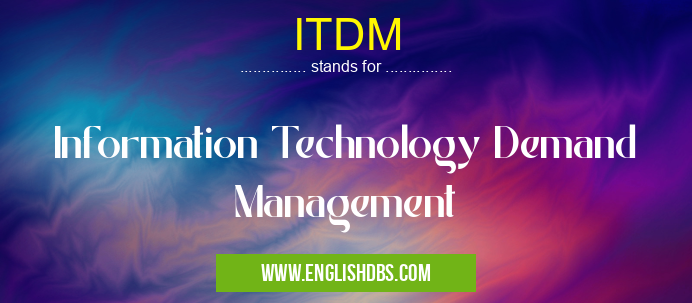What does ITDM mean in MANAGEMENT
ITDM stands for Information Technology Demand Management. It is a systematic approach to managing the demand for IT services within an organization. ITDM helps align IT resources with business needs, ensuring that IT investments are made in a way that supports the overall business strategy.

ITDM meaning in Management in Business
ITDM mostly used in an acronym Management in Category Business that means Information Technology Demand Management
Shorthand: ITDM,
Full Form: Information Technology Demand Management
For more information of "Information Technology Demand Management", see the section below.
» Business » Management
Key Components of ITDM
- Demand Forecasting: Predicting future demand for IT services based on historical data and business projections.
- Capacity Planning: Ensuring that IT resources are sufficient to meet current and future demand.
- Service Level Management: Defining and monitoring the performance of IT services to meet business requirements.
- Project Prioritization: Ranking IT projects based on their strategic importance and business impact.
- Resource Allocation: Distributing IT resources, such as budget and staff, to support the most critical projects.
Benefits of ITDM
- Improved Efficiency: Streamlines IT operations by aligning IT resources with business needs.
- Enhanced Collaboration: Fosters communication and collaboration between IT and business units.
- Increased ROI: Optimizes IT investments by ensuring that resources are allocated to projects with the highest potential for business value.
- Reduced Risk: Mitigates the risk of IT outages and other disruptions by proactively managing demand.
- Improved Customer Satisfaction: Delivers reliable and responsive IT services that meet the needs of customers and end-users.
Implementation Considerations
- Business Alignment: ITDM should be closely aligned with the overall business strategy.
- Data-Driven Approach: Demand forecasting and capacity planning should be based on reliable data and analysis.
- Stakeholder Involvement: Engage stakeholders from both IT and business units to ensure buy-in and support.
- Continuous Improvement: Regularly review and refine ITDM processes to ensure ongoing effectiveness.
Essential Questions and Answers on Information Technology Demand Management in "BUSINESS»MANAGEMENT"
What is Information Technology Demand Management (ITDM)?
ITDM is a systematic approach to managing the demand for IT services within an organization. It involves identifying, prioritizing, and managing IT service requests to ensure that the most critical needs are met with the available resources.
What are the benefits of ITDM?
ITDM can bring numerous benefits to organizations, including:
- Improved IT service delivery: By prioritizing requests, IT teams can focus on delivering the most essential services to the business.
- Optimized resource allocation: ITDM helps organizations allocate resources effectively, ensuring that IT spending aligns with business priorities.
- Increased transparency and accountability: ITDM provides a clear and transparent process for managing IT demand, making it easier to track progress and hold teams accountable.
- Enhanced customer satisfaction: By responding efficiently to critical service requests, ITDM helps improve customer satisfaction and build trust.
How does ITDM work?
ITDM typically involves the following steps:
- Demand identification: Identifying and capturing all IT service requests from users across the organization.
- Demand prioritization: Evaluating requests based on their business impact, urgency, and alignment with strategic goals.
- Demand management: Allocating resources and scheduling activities to meet prioritized requests while managing within budget constraints.
- Demand forecasting: Using historical data and predictive analytics to forecast future IT demand and plan for capacity needs.
What are the key components of an ITDM solution?
An effective ITDM solution typically includes the following components:
- Service catalog: A centralized repository of all available IT services and their associated costs and performance metrics.
- Request management system: A tool for submitting, tracking, and managing IT service requests.
- Prioritization engine: A mechanism for evaluating and prioritizing requests based on predefined criteria.
- Resource management system: A tool for managing IT resources and ensuring availability for service delivery.
- Reporting and analytics: A system for generating reports and dashboards to monitor ITDM performance and identify areas for improvement.
Final Words: ITDM is a critical tool for organizations seeking to optimize their IT investments and improve the alignment between IT and business. By proactively managing demand, organizations can ensure that their IT resources are used efficiently, effectively, and strategically to support their business objectives.
